Golden Gate
The Golden Gate is a strait on the west coast of North America that connects San Francisco Bay to the Pacific Ocean.[2] It is defined by the headlands of the San Francisco Peninsula and the Marin Peninsula, and, since 1937, has been spanned by the Golden Gate Bridge. The entire shoreline and adjacent waters throughout the strait are managed by the Golden Gate National Recreation Area.[3]
| Golden Gate | |
|---|---|
| Chrysopylae Boca del Puerto de San Francisco | |
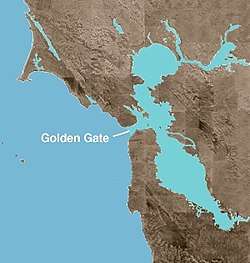 A map showing the location of the Golden Gate strait | |
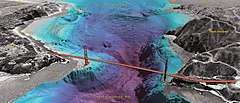 Perspective view looking southwest over the Golden Gate Bridge toward the Pacific Ocean. | |
| Location | Between San Francisco Peninsula and Marin Headlands |
| Coordinates | 37.81°N 122.50°W |
| Type | strait |
| Max. width | 3 miles (4.8 km) |
| Min. width | 1.1 miles (1.8 km) |
| Max. depth | 115 meters (377 ft)[1] |
| Settlements | San Francisco, CA |
Geology
During the last Ice Age, when sea level was several hundred feet lower, the waters of the glacier-fed Sacramento River and the San Joaquin River scoured a deep channel through the bedrock on their way to the ocean. (A similar process created the undersea Hudson Canyon off the coast of New York and New Jersey.) The strait is well known today for its depth and powerful tidal currents from the Pacific Ocean. Many small whirlpools and eddies can form in its waters. With its strong currents, rocky reefs and fog, the Golden Gate is the site of over 100 shipwrecks.
Climate
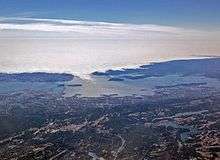
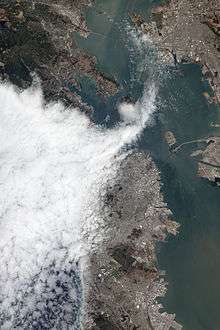
The Golden Gate is often shrouded in fog, especially during the summer. Heat generated in the California Central Valley causes air there to rise, creating a low pressure area that pulls in cool, moist air from over the Pacific Ocean. The Golden Gate forms the largest break in the hills of the California Coast Range, allowing a persistent, dense stream of fog to enter the bay there.[4] Although there is no weather station on Golden Gate proper, the area has a mediterranean climate (Köppen Csb) with very narrow temperature fluctuations, cool summers and mild winters. For the nearest weather station see the weatherbox of San Francisco. The Golden Gate Bridge being nearer the ocean and at elevation indicate it being cooler during summer days. Nearer the San Francisco urban core, the temperatures resemble the official NOAA weather station instead.
History
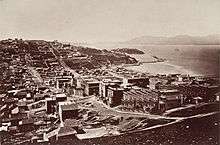
Before the Europeans arrived in the 18th century, the area around the strait and the bay was inhabited by the Ohlone to the south and Coast Miwok people to the north. Descendants of both tribes remain in the area.
The strait was surprisingly elusive for early European explorers, presumably due to persistent summer fog. The strait is not recorded in the voyages of Juan Rodríguez Cabrillo nor Francis Drake, both of whom may have explored the nearby coast in the 16th century in search of the fabled Northwest Passage. The strait is also unrecorded in observations by Spanish galleons returning from the Philippines that laid up in nearby Drakes Bay to the north. These galleons rarely passed east of the Farallon Islands (27 miles (43 km) west of the Golden Gate), for fear of the possibility of rocks between the islands and the mainland.
The first recorded observation of the strait occurred nearly two hundred years later than the earliest European explorations of the coast. In 1769, Sgt José Francisco Ortega, the leader of a scouting party sent north along the San Francisco Peninsula by Don Gaspar de Portolá from their expedition encampment in San Pedro Valley to locate the Point Reyes headlands, reported back to Portolá that he could not reach the location because of his encounter with the strait.[5] On August 5, 1775 Juan de Ayala and the crew of his ship San Carlos became the first Europeans known to have passed through the strait, anchoring in a cove behind Angel Island, the cove now named in Ayala's honor. Until the 1840s, the strait was called the "Boca del Puerto de San Francisco" ("Mouth of the Port of San Francisco"). On July 1, 1846, before the discovery of gold in California, the entrance acquired a new name. In his memoirs, John C. Frémont wrote, "To this Gate I gave the name of 'Chrysopylae', or 'Golden Gate'; for the same reasons that the harbor of Byzantium was called Chrysoceras, or Golden Horn."[6] He went on to comment that the strait was “a golden gate to trade with the Orient.”[7]
Gallery
 The Golden Gate as seen from off "Land's End" in Lincoln Park on the Northwest tip of the San Francisco Peninsula c. 1895.
The Golden Gate as seen from off "Land's End" in Lincoln Park on the Northwest tip of the San Francisco Peninsula c. 1895. San Francisco Bay and Golden Gate.
San Francisco Bay and Golden Gate. Passing Through the Golden Gate, by William A. Coulter.
Passing Through the Golden Gate, by William A. Coulter..tiff.jpg) Golden Gate, San Francisco, California.
Golden Gate, San Francisco, California.
1920s
In the 1920s, no bridge spanned the watery expanse between San Francisco and Marin in California—so when the U.S. Post Office issued a postage stamp on May 1, 1923, celebrating The Golden Gate, the issue naturally portrayed the scene without a bridge. The schooner sailing ship in the engraving is the USS Babcock, which served in the United States Navy from 1917 to 1919, and is seen passing through the Golden Gate into San Francisco Bay, its port of call.[8]

Golden Gate Bridge

The Golden Gate Bridge is a suspension bridge spanning the Golden Gate, the opening of the San Francisco Bay onto the Pacific Ocean. As part of both US Highway 101 and California Route 1, it connects the city of San Francisco on the northern tip of the San Francisco Peninsula to Marin County.
The Golden Gate Bridge was the longest suspension bridge span in the world when completed in 1937, and is an internationally recognized symbol of San Francisco and California in general. Since its completion, the span length has been surpassed by eight other bridges. It still has the second longest suspension bridge main span in the United States, after the Verrazano-Narrows Bridge in New York City. In 2007, it was ranked fifth on the List of America's Favorite Architecture by the American Institute of Architects.
Nautical transportation
The Golden Gate strait serves as the primary access channel for nautical travel to and from the San Francisco Bay, one of the largest cargo ports in the United States. Commercial ports includes the Port of Oakland, the Port of Richmond, and the Port of San Francisco. Commercial cargo ships use the Golden Gate to access the San Francisco Bay, as well as barges, tankers, fishing boats, cruise ships, and privately owned boats, including wind-surfers and kite-boards. About 9000 ships moved through the Golden Gate in 2014, and a similar amount in 2015.[9] The U.S Coast Guard maintains a Vessel Traffic Service to monitor and regulate vessel traffic through the Golden Gate.[10]
For navigational guidance, there are white and green lights on the center of the span of the Golden Gate Bridge.[11] Lighthouses with beacons and foghorns provide alerts at Point Bonita, Point Diablo, Lime Point and Mile Rocks. Before the Golden Gate Bridge was built, a lighthouse protected the south side of the strait at Fort Point. Buoys and radar reflectors provide additional navigational aid at various locations throughout the strait.[12]
See also
- Golden Gate, Oakland, California, a neighborhood
- Golden Gate Bridge, which extends across the Golden Gate strait
- Golden Gate National Recreation Area, a national park in the San Francisco Bay Area
- Golden Gate Park in San Francisco
References
- "Under the Golden Gate Bridge - Views of the Sea Floor Near the Entrance to San Francisco Bay, California". pubs.usgs.gov. Department of the Interior. Retrieved November 28, 2017.
- "GNIS Detail - San Francisco Bay". geonames.usgs.gov. U.S. Department of the Interior. Retrieved November 28, 2017.
- "SAN FRANCISCO NORTH, CA". USGS US Topo 7.5 - minute map. 2015. Retrieved November 29, 2017.
- James William Steele (1888). Rand, McNally & Co.'s New Overland Guide to the Pacific Coast: California, Arizona, New Mexico, Colorado, and Kansas. Rand, McNally. p. 175.
- Eldredge, Zoeth S. The beginnings of San Francisco. San Francisco: Zoeth S. Eldredge, 1912, 31-32.
- Gudde, Erwin G. California Place Names (2004) University of California Press, London, England. ISBN 0-520-24217-3.
- "What is a Name — The Golden Gate?". goldengatebridge.org. Golden Gate Bridge, Highway and Transportation District. Retrieved November 29, 2017.
- Juell, Rod. "Arago: 20-cent Golden Gate". arago.si.edu. Smithsonian Postal Museum. Retrieved November 29, 2017.
- "Golden Gate Ship Traffic". Marine Exchange of the San Francisco Bay Region: 2. 2015.
- "Reducing Ship Strike Risk to Whales - Policy and Management". sanctuaries.noaa.gov. National Oceanic and Atmospheric Administration. Retrieved November 29, 2017.
- "Chart 18649". www.charts.noaa.gov. National Ocean Service. Retrieved November 29, 2017.
- "LIGHT LIST, PACIFIC COAST AND PACIFIC ISLANDS" (PDF). United States Coast Guard. VI: 37. 2017. Retrieved November 29, 2017.
External links
| Wikimedia Commons has media related to Golden Gate. |
| Wikivoyage has a travel guide for San Francisco/Golden Gate. |
- National Park Service: Discovery of the Golden Gate
- Golden Gate 360 Image (QTVR)
- Golden Gate 360 Image (Java)
- Digitally Restored Panoramic Composited View of The Golden Gate, Fort Point, and San Francisco Bay as seen from "Land's End" near Sutro Heights, c. 1895.
- Adrift, time-lapse video by Simon Christen of fog pouring over the Marin Headlands and through the Golden Gate
